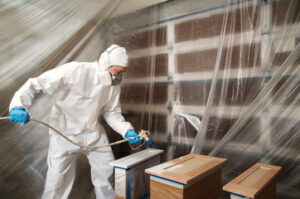Unlike new-construction windows, replacement windows don’t have fins that help them slide into openings. So accurate window measurements are important to get the best fit and seal. Contact Replacement Windows Potomac for professional help.

Window frames have a profound impact on the overall look and energy efficiency of a replacement window. They can add beauty, enhance the curb appeal of a home and improve the overall value of a property. Frame materials are available in a variety of finishes, shapes and sizes to fit the aesthetic goals and design preferences of a homeowner.
In addition, the type of frame material used will determine how well the replacement window will work with an existing home. For instance, the choice of full or insert replacement windows will play a crucial role in determining whether minor alterations to the original walls, trims and siding are required. This can be particularly important for older homes, where the integrity of the original windows and frames is a priority in maintaining the architectural integrity of a structure.
A full-frame replacement window includes a head across the top, jambs across the bottom and sills on either side. This installation method is often preferred for new construction projects and can provide a more seamless and durable result, particularly when the exterior of the home is finished in stucco or brick. It is also the best option when a homeowner wants to increase the amount of light coming into their home, and is generally the only choice when an existing window has become so deteriorated that it needs to be completely replaced.
The other alternative is an insert replacement window, which is designed to fit into the existing frame without removing the head, jambs and sills. This method of installation is often more cost-effective for homeowners, and can be especially helpful in situations where the existing window is in such poor condition that it would be unwise to invest in a complete replacement.
Insert replacement windows can be difficult for do-it-yourselfers to find in stores, since they are typically custom-made for each specific window. This means that they may require more time and patience to install than other options, although this can be mitigated by having a professional installer perform the work. They can also be more expensive than other replacement windows, and they tend to offer less customization options.
Glass
The window glass is one of the most important components of a replacement window. It affects both the energy efficiency and aesthetic appeal of your home. The type of glass you choose will depend on your preferences, as well as the overall design and size of your window.
Window glass is available in a range of thicknesses, with thicker options offering better insulation. It can also be tempered or laminated for safety and security purposes. Tempered glass breaks into dull shards rather than sharp pieces, reducing the risk of injury. The thickness of your glass will also impact how much light it allows into your home.
Homeowners are increasingly interested in maximising natural light and views. As a result, the popularity of slimline windows has grown. These feature narrow sashes (the part that moves up and down) and narrow panes, giving them a Colonial-style appearance. They also offer greater energy efficiency than traditional windows.
Other popular window glass trends include glazing with low-E coatings to reduce UV damage and help prevent fading of furniture. Insulated glass is also highly rated, helping to improve thermal performance and keep your home comfortable in all seasons.
In addition, homeowners are often concerned about the effect of climate change on their homes. As a result, they are choosing replacement windows that provide more insulation and are using fewer energy resources. In this way, they are minimizing their carbon footprint and contributing to a greener world.
Aside from enhancing home energy efficiency, replacing the glass in your windows can also address issues with drafts and condensation. This is particularly true if the sashes have shifted over time, leaving air pockets between the panes of glass. If you’re thinking about replacing only the glass in your windows, it’s a good idea to work with a professional glazier who can ensure that the new sash will fit properly.
The frame material you select will have a significant impact on the overall cost of your replacement windows. Wood frames are a classic choice, but require regular maintenance to protect against damage and rot. Vinyl is the most affordable option, and offers a wide selection of colors and excellent energy efficiency ratings. Fiberglass is another highly regarded option, but it’s not as durable as wood or vinyl. Many manufacturers offer composite frames that combine the best of both materials.
Sash
Located within the frame on either side of the glass, the sash is the portion of the window that allows you to open and close it. The sash sits in the frame’s head, or header, and rests on the top edge of the jambs.
If you’re removing the old sash to replace it with a new window, you need to take accurate measurements of the window opening before ordering your replacement windows. This will help ensure that you get the best possible fit for your new sash.
Start by measuring the width of your window opening. Use a tape measure to go from the inside corner of one window side jamb all the way to the opposite jamb, and then repeat this process for the other window side. The smallest of these numbers is your window width. Next, measure the height of your window opening. Start by measuring from the sill (where the exterior bottom of the sash contacts it) up to the top of the head jamb, and then repeat this process for both sides. Once you have the height and width measurements, choose the corresponding window sash size to complete your order.
You can also opt to have a professional install your replacement windows for you if you prefer not to do the work yourself. This option is especially useful if you want to ensure the highest level of expertise and accuracy with your window installation. Modernize can connect you with trusted local contractors who are experts at replacing sash windows.
Before beginning any work on your sash replacement, clear the area around your existing window to prevent debris from falling in your space. Remove any screens, storm windows, or shutters from the window. Then, take a clean, dry piece of paper and carefully write down your measured window opening sizes. Taking these measurements will make it easier for your contractor to create a budget quotation for your project.
Another option is insert window replacement, which is also known as frame-in-frame replacement. This type of installation is perfect if your existing frame is structurally sound and you’d like to preserve it. With insert windows, only the old sashes, hardware, and covers are removed to make room for the new window.
Hardware
In addition to boosting your home’s value, new replacement windows can help you save energy. However, it’s important to choose the right window for your home and budget. You should consider factors such as size, style and material, insulation and cost.
In general, ENERGY STAR windows are more efficient than older models. They have lower air leakage and less water condensation, which can improve your home’s energy efficiency. In addition, ENERGY STAR windows meet stricter building codes and can help you qualify for rebates.
A replacement window insert is installed in the existing frame without changing the exterior or interior trim of your house. This is a great option for homeowners who want to replace their windows but do not plan on major renovations. It is also possible to do a full-frame replacement, in which case the old window and frame are removed and replaced with a new window and trim.
The initial assessment: A professional determines the condition of your old window and frame to assess whether they are suitable for replacement. Accurate measurements are taken to ensure a custom fit. The window is ordered based on these dimensions.
Installation: The new window is installed into the existing frame using a nail fin frame, which is attached to the studs and drywall of your home. The nail fin is covered with weather stripping and flashing to prevent water infiltration.
The new window is then caulked and sanded to create a tight seal and eliminate drafts. If necessary, caulking and sanding can also be used to address issues with uneven frames or sills. In some cases, it may be necessary to paint the new window after installation to protect against moisture.
